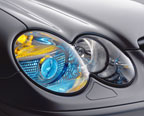Thursday, November 23

(NewsUSA) - Each year, approximately 5,000 pedestrians and
bicyclists are killed along U.S. roads - 2,300 of them occurring at night - and another 70,000
pedestrians are injured in traffic crashes, according to a 2003 National Highway Traffic Safety
Administration report.
New automotive lighting technologies, including Xenon and Adaptive
Front Lighting Systems, can help improve nighttime pedestrian safety, according to the Motor
Vehicle Lighting Council.
According to researcher Michael Flannagan of the University of
Michigan Transportation Research Institute, drivers "overdrive" the headlights on many of today's
vehicles, meaning they are going too fast to stop safely within the distance made visible by the
headlights.
"The critical safety need in low-beam lighting is seeing distance," Flannagan
said. "The maximum safe speed with today's average low beams is only about 45 mph. Our studies
indicate there is a major safety problem that headlights could address."
One possible
solution is Xenon headlights, also known as High Intensity Discharge or HID. Based on a gas
discharge process, Xenon uses an arc instead of a filament as a light source. The result is
enhanced roadway vision by increasing the light output to the sides of the road.
A 2004
University of Michigan Transportation Research Institute test revealed that Xenon headlamps
provided twice as much light for seeing critical objects on the road while producing 25 percent
less glare. The wider beam coverage also provides better lighting on road shoulders, where
pedestrians and bicyclists are commonly found.
Nearly 120 vehicle models equipped with
Xenon headlights were sold in North America in the 2005 model year -; up 21 percent from
2004.
Another emerging headlight technology is AFS or Adaptive Front Lighting System. It
provides optimal illumination in various driving conditions by automatically modifying the beam
pattern of the headlights in response to various speed, weather conditions and road situations. The
headlamps automatically move as the steering wheel is turned. This helps illuminate the road at an
earlier stage, allowing the driver more time to adjust and steer or brake as needed.
For
more information on new lighting technologies or the Motor Vehicle Lighting Council, visit www.mvlc.info.
Usa hotels
Subscribe to Comments [Atom]